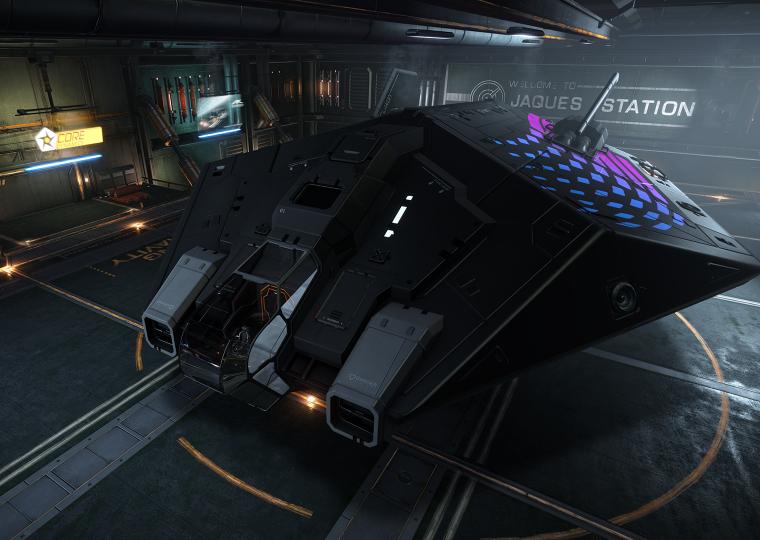CMDR Karise profile > Logbook

(Asp Explorer)

I've returned to the bubble! It's wonderful to see the lights of civilization again.

I made a deal with the Sirius Corporation for my exploration data. I found quite a few previously uncharted systems, so all my bills will be paid for a while. I'm getting some R&R while my ship gets a tune-up, but I told them to leave the paint as-is. I like the wear it's gotten out in the black.
I started my trip by heading for one of the largest stars in our galaxy, VY Canis Majoris. Now my last destination is one of the largest stars in close proximity to the bubble: Betelgeuse.

Betelgeuse is also a red supergiant, and it's predicted to explode into a supernova relatively soon in the galactic time scale: within the next million years. Hypothetically, it could explode at any point, even tomorrow. Until then, it will be the constellation Orion's bright shoulder. Come see it while you still can!

I wanted to visit the Eskimo Nebula even before I started my career as a CMDR. It's a bright bipolar double-shell planetary nebula fairly close to Sol, discovered by one of astronomy's earliest pioneers: William Herschel.

A highly luminous blue-white star lies inside the Nebula.

However, there's a surprise about 70,000 light-seconds away from this star...

...a small black hole!

In my excitement to get the best view, I got close enough that space-time started to deform. I don't recommend this. At least I got around to the other side.

After a lengthy trip across the Orio-Persean Gap, I approached the Flaming Star Nebula. It was described to me as "small" and "unremarkable," but I still think it's a wonderful sight.


I also stopped at the nearby Flaming Star Logistics Centre, another asteroid base in a rocky ring. I got a great view of both the Flaming Star Nebula and Barnard's Loop when I left the station.

The dark region of the Nebula visible from this side is quite striking, in my opinion! Barnard's Loop seems quite close from this vantage, but I'm only planning a few more stops before heading home.

On the next leg of my journey, I found an even more alarming neutron star. I didn't dare approach it! I quickly continued to the next system to get those gigantic cones out of view.

My approach towards the Jellyfish Nebula wasn't quite right to get the full effect of its "tentacles."

Traveling through the Nebula's cloud felt almost cozy. Everything is tinted a gentle, warm blush pink.

I docked inside the enigmatically-named Beta Site, an asteroid base tucked into the huge ring of a blue gas giant on the edge of the Nebula. It was surprisingly busy with several mining operations.

I took a last look back on the other side of the Nebula: it will be a long, dark trip across the gap between the Perseus Arm and the Orion Spur.

After days of travel through hundreds of star systems, I reached my farthest destination: the Crab Nebula and the pulsar at its heart. The Crab Pulsar was one of the first to be identified visually by Earth astronomers in the 20th century!
The nebula has a beautiful blue, green, and orange ejecta cloud.


Within the Nebula is Station X, one of the most remote human outposts. The station crew were eager for news from the bubble.

The Pulsar's light turns the surrounding clouds an ever deeper blue-green, like looking up from the bottom of a lake.

I left the Nebula in almost the same direction as I came: it's time to turn around and head back towards home.

On the next leg of my journey, I was surprised by a neutron star with extremely fast-spinning jet cones. I felt the same nervous fear of it as I did all the way back facing Jackson's Lighthouse. I successfully boosted my frame shift drive with no more damage than usual, but I will remember the whirlwind for a long time.

The Monkey Head Nebula (who comes up with these names?) was much dimmer than its neighboring nebulae.

The washed-out orange to purple light while traveling within it was quite calming in a certain way.

The Rosette Nebula is truly beautiful, surrounded by bright blue-white stars.

Many parts of the Nebula are a deep red color reminiscent of garnets, cherries, and wine.

The New Beginning base is a welcome spot of humanity this far out from the bubble.

The views after traveling all the way through the Nebula are just as spectacular.


I understand why it's called the Seagull Nebula now.

Of course no trip to the Seagull Nebula is complete without a stop at the infamous Hell Port. It's inside an asteroid orbiting a molten planet, near a red dwarf star, against the backdrop of the red Nebula.


The Port is run by the anarchic Black Rock Military and Black Flag Gang, and is home to the most questionable shipyard I've ever seen. I didn't stay long.
The Seagull Nebula is much bigger than Thor's Helmet. As I got closer, a vast red cloud loomed in front of my ship.

A large blue-white star sits in the heart of the Nebula.

After another 2,000 LY or so of travel, I reached Thor's Helmet Nebula. It's a small nebula and it's dim enough that you can also see the nearby Seagull Nebula while you're inside it.

On the other side of the nebula, I made a quick stop at the Sagan Research Centre. Yes, there are people out here, living in a small asteroid base!

It seems like a rough kind of place. I docked for a few hours to restock my field maintenance unit and have a hot meal.

One last close look at the Nebula, then I'm off to the next destination.

